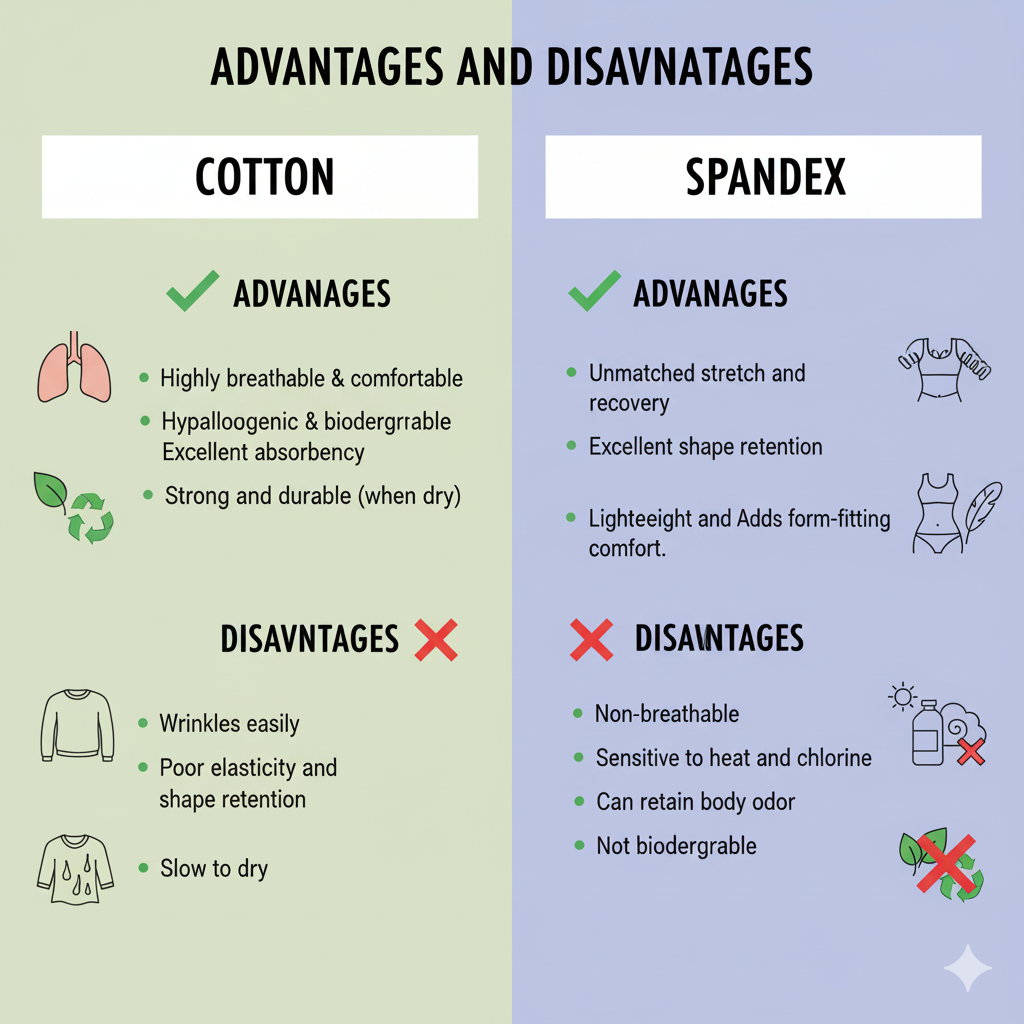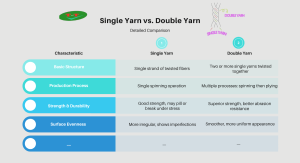In the world of textiles, the choice between natural comfort and engineered performance often comes down to two fundamental fibers: cotton and spandex. While one offers timeless breathability, the other delivers unmatched flexibility. But what happens when you combine them?
This guide explores the core differences between cotton and spandex and reveals how their powerful synergy creates the versatile, high-performance Cotton Spandex Fabric that dominates modern apparel.
Cotton and Spandex: Fundamental Definitions
Understanding the origin and inherent nature of each fiber is crucial to appreciating their roles in fabric creation. They represent a perfect dichotomy: one from nature, the other from the lab.

- Cotton is a natural, cellulosic fiber harvested from the bolls of the cotton plant. For thousands of years, it has been prized for its softness, breathability, and hypoallergenic properties. As a plant-based fiber, it is biodegradable and feels naturally comfortable against the skin, making it the world’s most popular natural fiber for everything from everyday t-shirts and denim to bed linens and towels.
- Spandex, also known as elastane, is a synthetic polymer derived from polyurethane. Created in a laboratory, its defining characteristic is exceptional elasticity. It can stretch up to 500-600% of its original length and recover perfectly. Spandex is almost never used alone; instead, it is added in small percentages (typically 2%-20%) to other fabrics to provide strategic stretch and shape retention.
Cotton and Spandex: A Head-to-Head Comparison
This detailed comparison highlights the contrasting properties that make each fiber unique.

| Property | Cotton | Spandex |
| Origin | Natural (Plant-based) | Synthetic (Polyurethane) |
| Breathability | Excellent – Allows maximum air circulation. | Poor – Traps heat and moisture against the skin. |
| Moisture Management | Highly Absorbent – Holds up to 27 times its weight in water, but dries slowly. | Hydrophobic – Repels moisture and dries very quickly. |
| Stretch & Recovery | Minimal – Has little inherent stretch and poor recovery (bags out). | Exceptional – Unmatched elasticity with perfect snap-back. |
| Durability | Strong when dry but weakens when wet; prone to pilling and abrasion over time. | Very Strong – Highly resistant to wear from body oils, sweat, and abrasion. |
| Comfort & Hand Feel | Soft, Natural, and Non-Irritating. | Can feel synthetic; not designed for direct skin contact in pure form. |
| Heat Sensitivity | Can handle high heat but is prone to shrinking. | Highly Sensitive – High heat from dryers or irons can melt it or destroy its elasticity. |
| Applications | Casual wear, loungewear, bed linens, towels. | Activewear, swimwear, shapewear, compression garments. |
| Cost & Market Potential | Cost varies with quality; stable, high-volume market. | Higher cost per kg; growing market driven by demand for comfort stretch. |
Advantages and Disadvantages of Cotton and Spandex
A clear summary of the pros and cons helps in making informed material choices.

| Cotton and Spandex | Advantages | Disadvantages |
| Cotton | – Highly breathable & comfortable – Hypoallergenic & biodegradable – Excellent absorbency – Strong and durable (when dry) | – Wrinkles easily – Prone to shrinking – Poor elasticity and shape retention – Slow to dry |
| Spandex | – Unmatched stretch and recovery – Excellent shape retention – Lightweight and durable – Adds form-fitting comfort | – Non-breathable – Sensitive to heat and chlorine – Can retain body odor – Not biodegradable |
Cotton Spandex Fabric: The Perfect Hybrid Solution
The limitations of pure cotton and pure spandex are precisely why their blend is so revolutionary. Cotton Spandex Fabric is the intelligent hybrid that leverages the strengths of both fibers while mitigating their weaknesses.

By combining a high percentage of cotton (e.g., 95-98%) with a small amount of spandex (e.g., 2-5%), this fabric achieves a perfect balance. It retains the soft, breathable, and comfortable feel of natural cotton while gaining the flexibility, fit, and shape retention of spandex. The result is a fabric that moves with the body, resists wrinkling and bagging, and offers superior durability compared to 100% cotton.
This is why Cotton Spandex Fabric has become the gold standard for modern apparel, including:
- Fitted T-shirts and Tops: That hold their shape wash after wash.
- Leggings and Athleisure Wear: Offering comfort for both activity and relaxation.
- Modern Denim and Pants: Providing comfort without sacrificing style.
- Form-Fitting Dresses and Skirts: That allows for ease of movement.
Conclusion: Choosing the Right Fiber for Your Needs
Selecting the right material is not about finding a “better” fiber, but about choosing the right tool for the job. Your decision should be guided by the intended use of the final garment.
- Choose 100% Cotton for projects where ultimate breathability and natural comfort are the top priorities, and stretch is not required. This includes basic t-shirts, pajamas, bed linens, and towels.
- Choose a Cotton Spandex Fabric for virtually any application where both comfort and movement are essential. If you want a garment to be soft, breathable, and maintain a fitted shape without restriction, this blend is the unequivocal winner.
- Pure Spandex is reserved for technical applications requiring extreme elasticity, always used as a component within a blend for activewear, swimwear, and shapewear.
The journey from field to fabric showcases a brilliant partnership: nature’s offering of comfort, perfected by science’s gift of movement.
Ready to leverage the perfect blend for your next collection? Contact our fabric experts today to explore our premium range of Cotton Spandex fabrics and find the ideal material for your designs.
TANI THREAD CO., LTD
- Address: Thanh Hoa Hamlet, Thanh Dien Commune, Chau Thanh District, Tay Ninh Province, Vietnam
- Hotline: 0984.841.239
- Email: sale@tanithread.com
- Website: tanithread.com
- Fanpage: Tani Thread



